美英报刊阅读lesson2
- 格式:pptx
- 大小:2.39 MB
- 文档页数:44
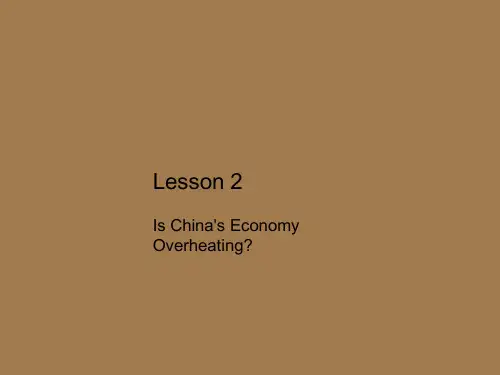
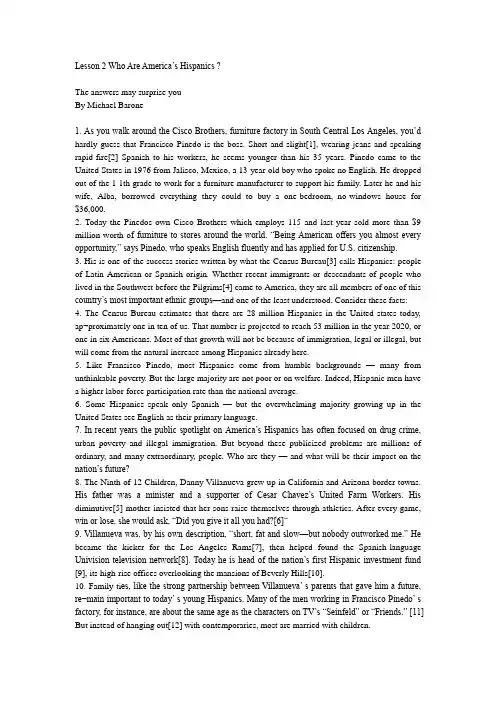
Lesson 2 Who Are America‟s Hispanics ?The answers may surprise youBy Michael Barone1. As you walk around the Cisco Brothers, furniture factory in South Central Los Angeles, you‟d hardly guess that Francisco Pinedo is the boss. Short and slight[1], wearing jeans and speaking rapid-fire[2] Spanish to his workers, he seems younger than his 35 years. Pinedo came to the United States in 1976 from Jalisco, Mexico, a 13-year-old boy who spoke no English. He dropped out of the 1 1th grade to work for a furniture manufacturer to support his family. Later he and his wife, Alba, borrowed everything they could to buy a one-bedroom, no-windows house for $36,000.2. Today the Pinedos own Cisco Brothers which employs 115 and last year sold more than $9 million worth o f furniture to stores around the world. “Being American offers you almost every opportunity,” says Pinedo, who speaks English fluently and has applied for U.S. citizenship.3. His is one of the success stories written by what the Census Bureau[3] calls Hispanics: people of Latin American or Spanish origin. Whether recent immigrants or descendants of people who lived in the Southwest before the Pilgrims[4] came to America, they are all members of one of this country‟s most important ethnic groups—and one of the least understood. Consider these facts:4. The Census Bureau estimates that there are 28 million Hispanics in the United states today, ap¬proximately one in ten of us. That number is projected to reach 53 million in the year 2020, or one in six Americans. Most of that growth will not be because of immigration, legal or illegal, but will come from the natural increase among Hispanics already here.5. Like Fransisco Pinedo, most Hispanics come from humble backgrounds —many from unthinkable poverty. But the large majority are not poor or on welfare. Indeed, Hispanic men havea higher labor-force participation rate than the national average.6. Some Hispanics speak only Spanish —but the overwhelming majority growing up in the United States see English as their primary language.7. In recent years the public spotlight on America‟s Hispanics has often focused on drug crime, urban poverty and illegal immigration. But beyond these publicized problems are millions of ordinary, and many extraordinary, people. Who are they — and what will be their impact on the nation‟s future?8. The Ninth of 12 Children, Danny Villanueva grew up in California and Arizona border towns. His father was a minister and a supporter of Cesar Chavez‟s United Farm Workers. His diminutive[5] mother insisted that her sons raise themselves through athletics. After every game, win or lose, she would ask, “Did you give it all you had?[6]“9. Villanueva was, by his own description, “short, fat and slow—but nobody outworked me.” He became the kicker for the Los Angeles Rams[7], then helped found the Spanish-language Univision television network[8]. Today he is head of the nation‟s first Hispanic investment fund[9], its high-rise offices overlooking the mansions of Beverly Hills[10].10. Family ti es, like the strong partnership between Villanueva‟ s parents that gave him a future, re¬main important to today‟ s young Hispanics. Many of the men working in Francisco Pinedo‟ s factory, for instance, are about the same age as the characters on TV‟s “Seinfeld” or “Friends.” [11] But instead of hanging out[12] with contemporaries, most are married with children.11. According to the most recent statistics, 37 percent of Hispanic households are composed of two parents raising minor[13] children—as compared with 25 percent of non-Hispanic Americans. Divorce is significantly less common among Hispanics than among non-Hispanics.12. Sleepless in El Paso. As a boy, Cesar Viramontes crossed the Mexican border to El Paso, Texas, knowing no English. He dropped out of high school to work in a laundry. Then he and his wife saved enough money to buy a laundromat[14] When the fashion for prewashed[15] jeans started, the Viramontes family got into the business. Closing the laundromat at 10 p.m., they‟ d set the machines spinning with jeans from local manufacturers. Then they‟ d clean out the blue water and lint[16] before customers arrived at 7 a.m. All for 15 cents a pair.13. When did they rest? “We didn‟t,” says Cesar Viramonters. “You can sleep when you‟re 60.” Today the family owns International Garment Processors, which employs more than 750 workers at two large plants just outside El Paso. The company processes 50,000 garments a day for Levi Strauss[17] and other makers, and grosses [18] more than $30 million a year.14. America‟s Hispanics are known as hard workers. “Latinos[19] have a strong work ethic[20] and strong loyalty to employers,” says Jose de Jesus Legaspi, a real-estate developer who came to Los Angeles from Mexico as a teen-ager. Their attitude, he says, is: “I‟m asked to do this job, and 1 go and do it. If I need more money, I‟ll get an extra job.”15. Statistics back up Legaspi‟ s opinion: the percentage of Hispanic men in the labor force in 1996 was 80 percent, well above the U.S. average of 67 percent. And many are entrepreneurs: the number of Hispanic-owned businesses rose to 863,000 in 1992, with receipts of $77 billion.16. All Together Now. In 1994 (the last figures available)[21], Hispanic income per person was only 57 percent of the national average—reflecting low earnings by immigrants with little English and few marketable skills. But often several people in each family work, so average Hispanic household income was 73 percent of the U.S. average.17. This is one way immigrants work themselves up to the middle class. Mexican-born Elena Lomeli is a top assistant to Laurie Gates, a pottery designer whose work appears in leading department stores. Arriving here in 1969 at age 13 and knowing no English, Lomeli baby-sat and did housekeeping. Today sh e helps transform Gates‟ s designs into finished products. “I surprise myself every day by what we do here,” she says.18. The Language Crisis. When Miami lawyer Nicolas Gutierrez, Jr., was interviewed on Span¬ish-language television, his Cuban-born family called him later to “correct what 1 got wrong,”[22] he says. Although he grew up hearing Spanish at home, he spoke English in school, college and law school—and speaks it today in his business and personal life.19. Today, in many workplaces and with family and friends, Spanish is usually the choice for Hispanic immigrants. As a result, many critics of immigration worry that Hispanic America will become a separate, Spanish-language community.20. It‟s an old controversy, one that also raged early this cent ury when Italian, Polish and Jewish immigrants did not learn English. But the second generation did. And the experience of Nick Gutierrez and many others is reason to believe that things are no different today.21. Indeed, more than three-quarters of U.S.-born Hispanics have a solid command of English[23]. And in a 1996 poll conducted for the Center for Equal Opportunity, 51 percent of Hispanic parents said that learning to read, write and speak English was the most important goal of their children‟ s education; only 11 percent said the same of Spanish.22. Unfortunately, public schools—the great entryway to American success for the children ofearlier immigrants—have not served Hispanic students well. Part of the problem: the “experimental” bilingual educat ion programs started a generation ago. Technically voluntary[24], these programs enlist many Hispanic children regardless of parents‟ wishes. States such as California and Illinois can keep pupils in bilingual classes for five years. The effect is to hold back children from learning the English that they need and their parents desire.23. And because many Hispanic students are thus ill-prepared when they get to college, bilingual programs have even found a foothold there. Herman Badillo, a former New York City Congressman of Puerto Rican descent, spoke to one student from Hostos Community College, a bilingual branch of the City University of New York. The woman had failed a required English-proficiency test twice. “She couldn …t speak fluent English, and she‟d majored in gerontology and gotten a job in a nursing home,” Badillo said. “If she‟s working with elderly people who don‟t speak Spanish, it will be a calamity.”24. Clearly, reform of bilingual education programs is long overdue[25].25. Citizens Who Vote. Eighty years ago it was said that Italian immigrants would never be ab¬sorbed into mainstream society. Yet in time they became unequivocally American. Today, writes cultural critic John Leo[26], ” Hispanics are blending into the general population at l east as fast as earlier white ethnic groups did.”26. In the past two years Hispanics have become U.S. citizens at a record pace[27]. Already the largest ethnic minority, they will in time be the largest voting bloc—maybe even the majority—in several of our largest metropolitan areas. And competition for Hispanic votes is becoming as politically crucial as past battles for immigrants‟ votes.27. Texas and California, the nation‟s two largest states, with the two largest Hispanic populations, have already de veloped very different Hispanic politics. Hispanics in Texas‟ s Congressional delegation, for example, include a conservative Republican as well as both conservative and liberal Democrats. In California—with 54 electoral votes, 20 percent of those needed to win the Presidency—Hispanic voters tend to favor government-spending programs[28] and activism, positions that usually help liberal Democrats. But they are also likely to support capital punishment[29] and oppose abortion, views that help Republicans.28. In any event, the GOP[30] could pay a high price if it is perceived as engaging in immigrant-bashing[31]. In 1994, for example, one in four Hispanics voted for California‟s Proposition 187[32], which barred state aid to illegal immigrants. But many resented Republican Governor Pete Wilson‟ s ads for the measure, which they thought labeled all Hispanics as lazy. Two years later the Republicans‟ share of the Hispanic vote sharply declined.29. Whatever they may be in the future, Hispanic preferences and priorities are likely to strongly influence the direction of our politics and government. But it will be American politics.30. Consider Texas Congressman Silvestre Reyes. Growing up in a small Texas town, he learned English at school, served in Vietnam and then got a job with the Border Patrol[33]. In 1993 he devised Operation Hold the Line[34], which stationed agents at the border along the Rio Grande and vastly reduced the flow of illegal immigrants. In 1996 he was elected to Congress.31. A reporter once a sked him, “How do you guys celebrate independence day?”32. “With fireworks and a picnic,” Reyes replied.33. The writer was surprised. “I had no idea you celebrated the 16th of September [Mexico's independence day] that way,” he said.34. Reyes explained: “I‟m talking about the Fourth of July.”From Reader‟s Digest, January, 1998V. Analysis of Content1. Hispanics may refer to____________.A. Americans of Latin American or Spanish originB. recent immigrants to America from South AmericaC. descendants of people who lived in the Southwest before the Pilgrims came to AmericaD. immigrants from Spain2. From the article, we know that ___________A. the number of Hispanics will reach 53 million in 2020 because of increasing immigrationB. most Hispanics are poor and on welfareC. the employment rate of Hispanic men is higher than the national averageD. the Hispanics see Spanish as their primary language3. Which of the following statement is wrong ?A. Family ties remain important to today‟ s you ng Hispanics.B. All Hispanic men are likely to hang out with their contemporaries.C. Divorce among Hispanics is not so common as among non-Hispanics.D. Hispanic families are relatively stable.4. What‟s the effect of the “experimental” bilingual edu cation programs to Hispanic children?A. They can speak both Spanish and English fluently.B. It holds back children from learning the English that they need and their parents desire.C. It has well prepared Hispanic students.D. It helps the children to learn English.5. In 1996 the Republicans‟ share of the Hispanic vote sharply declined because___________A. Hispanics in California are against the Republicans‟ platformB. Hispanics in California are for liberal Democrats‟ platformC. California‟s Proposition 187 is unreasonableD. the Republican Governor Pete Wilson had bashed HispanicsVI. Questions on the Article1. Why does the author say one would hardly guess that Francisco Pinedo is the boss?2. In recent years, what have been the publicized problems with Hispanics?3. Can you tell how Cesar Viramontes succeeded in his business?4. Will Hispanic America become a separate, Spanish language community as many critics worry?5. Why is the competition for Hispanic votes becoming as politically crucial as past batties for immigrants‟ votes?VII. Topics for Discussion1. How do you interpret Pinedos‟ words “Being American offers you almost every opportunity”?2. Is bilingual education necessary for Hispanics?。


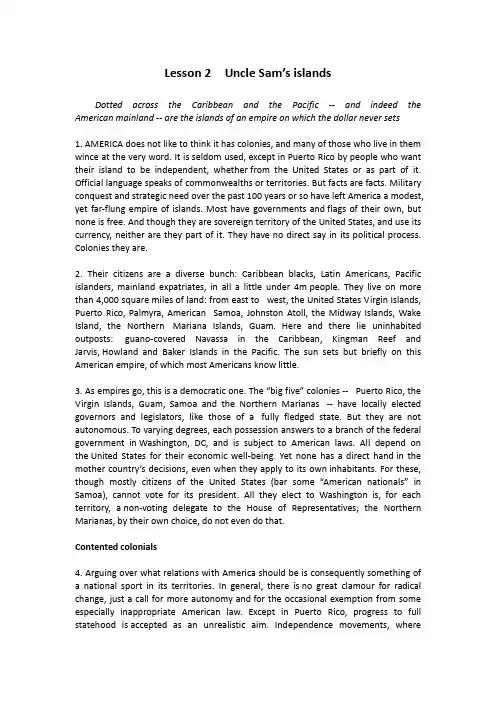
Lesson 2 Uncle Sam’s islandsDotted across the Caribbean and the Pacific -- and indeed the American mainland -- are the islands of an empire on which the dollar never sets1. AMERICA does not like to think it has colonies, and many of those who live in them wince at the very word. It is seldom used, except in Puerto Rico by people who want their island to be independent, whether from the United States or as part of it. Official language speaks of commonwealths or territories. But facts are facts. Military conquest and strategic need over the past 100 years or so have left America a modest, yet far-flung empire of islands. Most have governments and flags of their own, but none is free. And though they are sovereign territory of the United States, and use its currency, neither are they part of it. They have no direct say in its political process. Colonies they are.2. Their citizens are a diverse bunch: Caribbean blacks, Latin Americans, Pacific islanders, mainland expatriates, in all a little under 4m people. They live on more than 4,000 square miles of land: from east to west, the United States Virgin Islands, Puerto Rico, Palmyra, American Samoa, Johnston Atoll, the Midway Islands, Wake Island, the Northern Mariana Islands, Guam. Here and there lie uninhabited outposts: guano-covered Navassa in the Caribbean, Kingman Reef and Jarvis, Howland and Baker Islands in the Pacific. The sun sets but briefly on this American empire, of which most Americans know little.3. As empires go, this is a democratic one. The “big five” colonies -- Puerto Rico, the Virgin Islands, Guam, Samoa and the Northern Marianas -- have locally elected governors and legislators, like those of a fully fledged state. But they are not autonomous. To varying degrees, each possession answers to a branch of the federal government in Washington, DC, and is subject to American laws. All depend on the United States for their economic well-being. Yet none has a direct hand in the mother country’s decisions, even when they apply to its own inhabitants. For these, though mostly citizens of the United States (bar some “American nationals”in Samoa), cannot vote for its president. All they elect to Washington is, for each territory, a non-voting delegate to the House of Representatives; the Northern Marianas, by their own choice, do not even do that.Contented colonials4. Arguing over what relations with America should be is consequently something ofa national sport in its territories. In general, there is no great clamour for radical change, just a call for more autonomy and for the occasional exemption from some especially inappropriate American law. Except in Puerto Rico, progress to full statehood is accepted as an unrealistic aim. Independence movements, wherethey exist at all, find little local support. Puerto Rico’s main pro-independence party gets only about 6% of the vote in elections for governor, though its leader, Mr Ruben Berrios Martinez, is one of the island’s most dynamic politicians.5. Resentment against Washington’s occasional high-handedness is more than offset by the benefits it provides. And it gives more than it takes. Uncle Sam, doubtless mindful of what happened to George III, does not claim federal income tax from residents of the territories, thus allowing the local authorities to claim the revenue. In some cases Washington provides grants for these local governments. Yet the colonials can claim many of the personal benefits on offer to taxpaying citizens in the 50 states.6. Harder to put figures on, but no less palpable, is the economic benefit of being American. Virgin Islanders thrive on tourism from the mainland United States. Puerto Rico has recently had a higher annual growth rate than the mainland, thanks in part to investment in the island by American companies attracted to it by its combination of tax breaks and political stability. It is unlikely that independence would have brought any of America’s possessions to their present economic level. The Virgin Islands’GNP per head ($ 9,750 in 1986) is four times that of independent Antigua and Barbuda nearby.7. The rights of American citizenship include the right to live and work on the mainland. More than 2m Puerto Ricans live in the United States proper, notably in New York. So, mainly in Hawaii, California and Washington state, do around 85,000 Samoans -- more than twice the population of American Samoa itself.8. Here, not least for the use of Americans, is a brief gazetteer of their empire. Populous Puerto Rico18989. The “shining star of the Caribbean” has, on the face of it, the least excuse for beinga colony. Surrounded by former European colonies now independent, Puerto Rico is the fourth largest island in the Caribbean, with a population of some 3.3m and a 1987 GNP of $ 18 1/2 billion. Columbus landed here in 1493, and for 400 years it was a colony of Spain. Its history is evident throughout the island, from the splendid Spanish-colonial governor’s mansion, La Forteleza, in San Juan, to the shanties in the mountains. English is an official language, but in practice comes a distant second behind the other one, Spanish.10. Yet Puerto Rico is American, and generally proud of it. It became an American colony in 1898 after the Spanish-American war. Its people became American citizens in 1917, and the territory was given ”commonwealth”status in 1952. Since then it has seen a vigorous but ometimes debilitating debate over the next step: whether tostick with this ill-defined, quasi-autonomous status, to become a full state or to go independent. Were it to become the 51st of the United States, Puerto Rico would rank 51st in wealth: its income per head is only two-thirds that of Mississippi, America’s poorest state today.11. But Puerto Rico is not likely to become either a full state or independent in the near future. Though President Bush is in favour of statehood, when the islanders vote again on their future status, possibly in 1991, they will most probably choose to stay much as they are. The proposal for “enhanced commonwealth” status is likely to get most votes, quite possibly an overall majority. The vote for statehood will be significant, but would have to be well above 50% for Washington seriously to consider accepting the idea. The backers of independence will do well to reach double figures.12. In politics, this division dominates everything. The arguments for statehood and independence alike are admirably democratic and emotional; those for continued commonwealth status -- backed by the current governor, Mr Rafael Hernandez Colon, and a majority of the island’s legislators -- are persuasively economic.13. At present, Puerto Rico does very nicely out of American tax law, in particular Section 936, which allows American companies, already exempt from American tax on business done there, to transfer profits back to their mainland headquarters without incurring tax. The island’s government credits these breaks with it $ 9 billion a year of manufacturing output and recent growth rates as high as 5%. With unemployment near 19%, that growth is not something lightly to be put at risk.14. To protect its tax breaks from budgetcutters in Washington, Puerto Rico has developed its own version of President Reagan’s Caribbean Basin initiative. It lends money to other Caribbean countries for development and helps American companies to set up twin plants in those countries and in Puerto Rico. Fomento, the island’s impressive development agency, says that this local initiative has already created some 10,000 jobs in 11 Caribbean countries. By these means Puerto Rico sells itself to Washington as a kind of half-way house between America and the Caribbean. It is an ironic role-reversal: a colony coming to the aid of independent but poorer neighbours.Various Virgins191715. Step out of the airport terminal and you will swiftly see that the United States Virgin Islands are not like anywhere in America: your taxi is driving on the left. The Danes, from whom the United States bought the islands in 1917 for $ 25m, to protect the Panama Canal from German submarines, drive on the right themselves, but succumbed to the influence of the British Caribbean. That tradition lives on,even thought the cars obeying it are American one, build the wrong way round.16. A mile, at the nearest point, from the sleepy British Virgin Islands, the territory consists of about 50 small islands and three larger ones, at the northernmost sweep of the Lesser Antilles. The bigger islands -- St Thomas, St Croix and St John -- are home to about 106,000 people, 80% of them black and manifestly West Indian black. Two-thirds of St John is a breathtakingly lovely national park; St Thomas and St Croix, also beautiful, are daiquiri fuelled, yacht-clogged playgrounds for wealth Americans.17. The islands have next to no natural resources beyond their beauty and climate. But these are enough: more than 1.7m visitors come each year, many on cruise ships. They spend about $ 620m -- half of the islands’ $ 1.25 billion gross territorial product. When they are not sailing, swimming or sunning, the visitors are shopping. This is a duty-free zone, and mainland residents can take up to $ 800-worth of tax-free souvenirs home with them from the jewellery bazaars of Charlotte Amalie, Christiansted and Frederiksted. There is another industry: making watch movements, $ 5m-worth of which were exported in 1987. But the big employers, with 31% of the labour force, are the federal and local governments.18.A few rich mainlanders live on the islands; one-third of the other inhabitants live below the official poverty line. The cost of living (like the crime rate) is high. Yet the citizens of this American colony are much better off than most independent Caribbean citizens.19. And they know it. In November, when they vote on the territory’s status they will probably opt for continued ties with America, albeit with the usual request for more autonomy. Independence will be on the ballot, and the islands’governor, Mr Alexander Farrelly, says Washington may be surprised by the support it attracts. The federal government is seen as meddling too much in island affairs. It is a fair bet, however, that the resentment will be held in check by a reasonable fear that not so many wealthy Americans would visit the islands were they not safely part of the American family.Sleepy Samoa1900-190420. Across the Pacific, the citizens of America’s only sizable possession in the southern hemisphere are in no hurry for change. The last look American Samoa took at relations with the mother country was conducted by a “Second Temporary Future Political Status Commission”. It reported, in 1979, that the way ahead was to take another look in 10-15 years’ time.21. American Samoans are equally relaxed in their approach to democracy. It took intheir approach to democracy. It took three plebiscites to get them to agree that the territory should have an elected governor. Their legislature’s upper house is appointed by village elders. Traditional garb is the norm, even among the most westernised Samoans. Existence is dominated by “Fa’a Samoa” a concept that literally means the Samoan way of life but that can be more usefully translated as that which mystifies outsiders.22. The result is that American Samoa is the least assimilated of all the United States’colonies, and possibly the poorest -- facts which, by and large, do not much bother its inhabitants. The colony’s government is the largest employer, with 38% of the officially recorded labour force, followed by two tuna canneries with 37%. Estimated income per head is only $ 1,850 -- which is still 3 1/2 time that of independent Western Samoa, 80 miles to the west.23. The colony consists of seven islands, 1,600 miles north-east of New Zealand, witha population of 38,000, most of whom live on the main island of Tutuila. By arrangement with Britain and Germany, the United States took the islands -- sorry, had them ceded by local chiefs -- between 1900 and 1904. Until 1951 they were run by the American navy, which liked the harbour at Pago Pago and originally used it as a coaling station. In 1925 Congress gave American Samoa its own colony, annexing tiny Swain’s Island 180 miles to the north-west. The 27 or so Swain’s Islanders send a delegate to the American Samoan legislature. Non-voting, of course.Grumbling Guam189824. The largest and most southerly island of the Marian archipelago, Guam is the most populous American possession in the Pacific, with about 130,000 people crowded on to its 210 square miles. A bit over 40% of them are native Chamorros, the rest Filipinos, other Asians and mainland Americans. Guam, once a Spanish colony, bills itself as the place “where America’s day begins”. In fact, it doesn’t: tiny Wake Island, just to the west of the international date line sees the dawn a good hour earlier. Guam’s sense of its place in the imperial sun is equally uncertain.25. Guamanians are proud to be American, and have little interest in becoming independent. But they are not content either with their current relations with the United States, which resemble those of the Virgin Islands. Among the issues that rankle is Guam’s inclusion in the protectionist Jones act, which requires that American ships be used between American ports. To islanders who live 3,700 miles west of Hawaii this seems inappropriate, for all its sixteenth-century Spanish imperial precedents.26. In 1987 the islanders voted to ask the federal government to give their territory more autonomy and make it a commonwealth much like Puerto Rico. A bill to thateffect has been introduced in Congress. But it is unlikely to make speedy headway, in part because the Guamanians ignored Washington’s instructions to negotiate the matter first and vote later.27. Guam did well, economically, out of the Vietnam war. It has not done so well since. Today it tries to sell itself as a Pacific base for American companies, but with little success. The territorial and federal governments employ 45% of the workforce, and the economy is based on military spending (about $ 680m in 1987, including the pay of some 9,000 military personnel). Tourism, however, is prospering: around 1/2m people, most of them Japanese, visited the island in 1987. Their needs have set off a construction boom. And the economy may be looking up more generally: a recent analysis from the Bank of Hawaii suggests that Guam is heading for a new phase of growth.Much-disputed Marianas194728. Few Americans have ever heard of the Northern Mariana Islands. Plenty of Japanese have. Of 230,000 tourists in 1987, most came from Japan. There are many more today: the 16-island archipelago offers the nearest sun-drenched beaches to Tokyo, 1,400 miles to the north.29. The Northern Marianas have had a long colonial history. The Spanish held them for 300 years until Germany took over in 1898 (when Guam was split off to become American). After the first world war the League of Nations entrusted the islands to Japan, which in turn lost them after fierce fighting in the second world war; one of them, Saipan, is home to Suicide Cliff, where thousands of Japanese soldiers and civilians killed themselves in 1945. The islands then became an American trust territory.30. Most of America’s Pacific trust territories have by now gone their own way into independence (under America’s wing, of course). The Northern Marianas, in contrast, asked to join America’s empire, being accepted by Congress as a commonwealth in 1976. They got a good deal. Their covenant grants them various exemptions from American legislation, notably the Jones act and laws on immigration and minimum wages. Washington also gives the islands about $ 33m a year for development, for running the government and so on.31. Just what the island’s status means is less clear. Talk to an American official and he will tell you that they are very much like other American territories. Talk to one of the 21,000 islanders and he will speak of “internal sovereignty”, as if they were all bu independent.32. The gross island product in 1988 was almost $ 450m, more than five times -- inreal terms -- what it was in the late 1970s. Japanese investment is growing; seven of the islands’eight hotels are Japanese-owned. There is also a nascent clothing industry. One potential problem is the reliance on foreign labour; a third of the islands’inhabitants, including most private-sector employees, are from elsewhere.Democracy, DC179033. Beyond the “big five’, America’s empire consists of a variety of sparsely populated outcrops, most of which are military bases. Wake is run by the air force; the Midway Islands and Kingman Reef by the navy; Johnston Atoll by the Defence Nuclear Agency. Palmyra, 1,000 miles south of Hawaii, is privately owned.34. Two other dots on the map deserve mention. Palau, in the Pacific, is the sole remaining trust territory handed to America by the United Nations. It will become independent -- in “free association” with America -- when 75% of its people agree to America’s terms, which, in several votes, they have so far refused to do.35. And then there is the District of Columbia. The home of America’s federal administration and legislature enjoys only slightly greater democratic rights than do Uncle Sam’s other possessions. Its 620,000 residents murder each other with much greater freedom than, say the backward Samoans, and can even vote for the federal president (and pay federal taxes). But they still have only a non-voting delegate in Congress. Whenever the district gets uppity, as over abortion, or has other problems, such as its drug wars, Congress gets imperial and flexes its muscles.The Economist May 6, 1989ExercisesAnalysis of the content1. What the author means by “Sleepy” Samoa is that _____.A. Samoans like to sleepB. Samoans always look as if they want to sleepC. Samoans feel no hurry for changeD. Samoa is a tranquil place2. Which of the following islands has the longest history as a colony?A. Puerto RicoB. GuamC. the Northern MarianasD. American Samoa3. From the article we know that America’s poorest state is _____.A. AlaskaB. MississippiC. LouisianaD. Idaho4. Which of the following islands has the strongest sentiment for independence?A. Puerto RicoB. American SamoaC. GuamD. the Virgin Islands5. The author’s overall attitude towards the US policies concerning the islands is_____.A. highly criticalB. unkownC. rather positiveD. objectiveQuestions on the article1.What rights and benefits do the people on those islands enjoy according to thearticle?2.What difference exists between the US Virgin Islands and American in traffic?3.What kind of economy brings the Virgin Islands the greatest benefit?4.Of the island colonies, which one is the least assimilated?5.Which island is the place where America’s day begins?6.Give a brief account of the colonial history of the Northern Marianas.7.To whom are the Northern Marianas more familiar, Americans or Japanese?Why?8.What additional political rights do the people in the District of Columbia have? Topics for discussion1.Is it beneficial for those islands to remain under American’s control?2.Is America’s empire of islands a democratic one?。
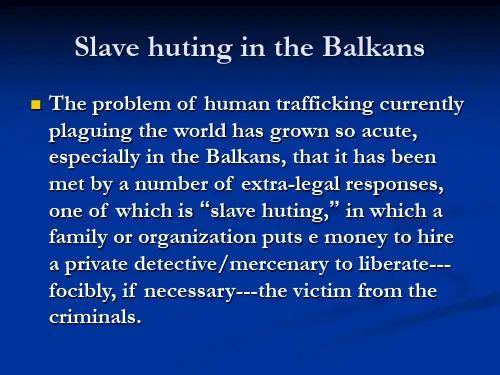



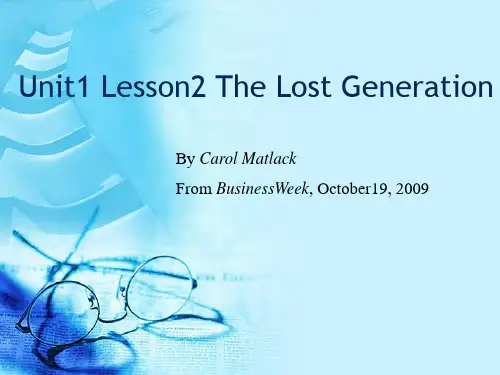
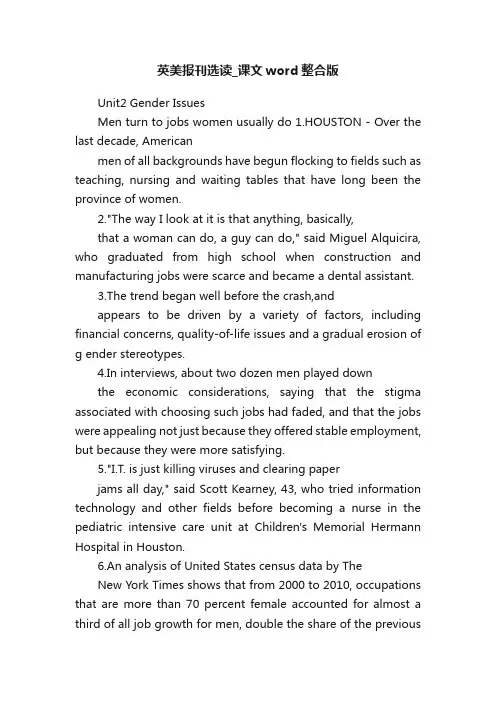
英美报刊选读_课文word整合版Unit2 Gender IssuesMen turn to jobs women usually do 1.HOUSTON - Over the last decade, Americanmen of all backgrounds have begun flocking to fields such as teaching, nursing and waiting tables that have long been the province of women.2."The way I look at it is that anything, basically,that a woman can do, a guy can do," said Miguel Alquicira, who graduated from high school when construction and manufacturing jobs were scarce and became a dental assistant.3.The trend began well before the crash,andappears to be driven by a variety of factors, including financial concerns, quality-of-life issues and a gradual erosion ofg ender stereotypes.4.In interviews, about two dozen men played downthe economic considerations, saying that the stigma associated with choosing such jobs had faded, and that the jobs were appealing not just because they offered stable employment, but because they were more satisfying.5."I.T. is just killing viruses and clearing paperjams all day," said Scott Kearney, 43, who tried information technology and other fields before becoming a nurse in the pediatric intensive care unit at Children's Memorial Hermann Hospital in Houston.6.An analysis of United States census data by TheNew York Times shows that from 2000 to 2010, occupations that are more than 70 percent female accounted for almost a third of all job growth for men, double the share of the previousdecade. 7.That does not mean that men are displacing women - those same jobs accounted for almost two-thirds of women's job growth. But in Texas, for example, the number of men who are registered nurses nearly doubled in that time period.8.The shift includes low-wage jobs as well.Nationally, two-thirds more men were bank tellers, almost twice as many were receptionists and two-thirds more were waiting tables in 2010 than a decade earlier.9.Even more striking is the type of men who aremaking the shift. From 1970 to 1990, according to a study by Mary Gatta, senior scholar at Wider Opportunities for Women, an organization based in Washington, D.C., and Patricia A. Roos, a sociologist at Rutgers University in New Jersey, men who took so-called pink-collar jobs tended to be foreign-born, non-English speakers with low education levels.10.Now, though, the trend has spread among men ofnearly all races and ages, more than a third of whom have a college degree. In fact, the shift is most pronounced among young, white, college-educated men like Charles Reed, a sixth-grade math teacher at Patrick Henry Middle School in Houston.11.Mr. Reed, 25, intended to go to law school after atwo-year stint with Teach for America, a national teacher corps of recent college graduates who spend two years helping under-resourced urban and rural public schools. But Mr. Reed fell in love with teaching. He says the recession had little to do with it, though he believes that, by limiting prospects for new law school graduates, it made his father, a lawyer, more accepting.12.To the extent that the shift to "women's work"has been accelerated by recession, the change may reversewhen the economy recovers. "Are boys today saying, 'I want to grow up and be a nurse?'" asked Heather Boushey, senior economist at the Center for American Progress."Or are they saying, 'I want a job that's stable and recession-proof?'"13.Daniel Wilden, a 26-year-old Army veteran andnursing student, said he had gained respect for nursing when he saw a female medic use a Leatherman tool to save the life of his comrade."She was a beast," he said admiringly.14.More than a few men said their new jobs werefar harder than they imagined. But these men can expect success. Men earn more than women even in female-dominated jobs. And white men in particular who enter those fields easily move up to supervisory positions, a phenomenon known as the glass escalator, said Adia Harvey Wingfield, a sociologist at Georgia State University.15."I hated my job every single day of my life," saidJohn Cook, 55, who got a modest inheritance that let him drop a $150,000-a-year database consultant's job to enter nursing school. 16.His starting salary will be two thirds lower, but database consulting does not typically earn hugs like the one Mr. Cook received from a girl after he took care of her premature baby sister. "It's like, people get paid for doing this kind of stuff?"Mr. Cook said, tears coming to his eyes as he recounted the episode.17.Several men cited the same reasons for seekingout pink-collar work that have drawn women to such careers: less stress and more time at home.At John G. Osborne Elementary School, Adrian Ortiz, 42,joked that he was one of the few Mexicans who made more in his native country, where he was a hard-working lawyer, than he did in the United States as a kindergarten teacher in a bilingual classroom. "Now," he said, "my priorities are family, 100 percent."18.Betsey Stevenson, a labor economist at theUniversity of Pennsylvania, said she was not surprised that changing gender roles at home, where studies show men are shouldering more of the domestic burden, are showing up in career choices. "We tend to study these patterns of what's going on in the family and what's going on in the workplace as separate, but they're very much intertwined," she said. "So as attitudes in the family change, attitudes toward the workplace have changed."19.In a classroom at Houston Community College,Dexter Rodriguez, 35, said his job in tech support had not been threatened by the tough economy. Nonetheless, he said, his family downsized the house, traded the new cars for used ones and began to live off savings, all so Mr.Rodriguez could train for a career he regarded as more exciting.20."I put myself into the recession," he said,"because I wanted to go to nursing school."Unit3 E-CommerceThe Post-Cash Economy1.In London, travelers can buy train tickets withtheir phones - and hold up the phones for the conductor to see. And in Starbucks coffee shops in the United States, customers can wave their phones in front of the cash register and pay for their soy chai lattes.2.Money is not what it used to be, thanks to theInternet. And the pocketbook may soon be destined for the dustbin of history - at least if some technology companies get their way.3.The cellphone increasingly contains theessentials of what we need to make transactions."Identification, payment and personal items," as Hal Varian, the chief economist at Google, pointed out in a new survey conducted by the Pew Research Center in Washington, D.C. "All this will easily fit in your mobile device and will inevitably do so."4.The phone holds and records plenty more vitalinformation: It keeps track of where you are, what you like and who your peers are. That data can all be leveraged to sell you things you never knew you needed.5.The survey, released last month by the PewResearch Center's Internet and American Life Project along with Elon University's Imagining the Internet Center in North Carolina, asked justover 1,000 technologists and social scientists to opine on the future of the wallet in 2020. Nearly two-thirds agreed that "cash and credit cards will have mostly disappeared" and been replaced with "smart" devices able to carry out a transaction.But a third of the survey respondents countered that consumers would fear for the security of transactions over a mobile device and worry about surrendering so much data about their purchasing habits.6.Sometimes, those with fewer options are theones to embrace change the fastest. In Kenya, a service called M-Pesa (pesa is money in Swahili) acts like a banking system for those who may not have a bank account. With a rudimentary cellphone, M-Pesa users can send and receivemoney through a network of money agents, including cellphone shops. And in India, several phone carriers allow their customers to pay utility bills and transfer small amounts of money over their cellphones.7.Several technology companies, big and small,are busy trying to make it easier for us to buy and sell all kinds of things without our wallets. A start-up,WePay, describes itself as a service that allows the smallest merchant - say, a dog walker - to get paid; the company verifies the reputations of payers and sellers by analyzing, among other things, their Facebook accounts. 8. A British start-up, called Blockchain, offers afree iPhone application allowing customers to use a crypto-currency called bitcoins, which users can mint on their computers.9. A company called Square began by offering asmall accessory to enable food cart vendors and other small merchants to accept credit cards on phones and iPads. Square's latest invention allows customers to register an account with Square merchants and pay simply by saying their names. The customer's picture pops up on the merchant's iPad.10.Google Wallet has been designed to sit in yourphone, be linked to your credit card, and let you pay by tapping your phone on a reader, using what is known as near field technology.But Google Wallet works on only four kinds of phones, and not many merchants are equipped for near field technology.11.Meanwhile, PayPal, which allows people tomake payments over the Internet, has quietly begun to persuade its users to turn to their cellphones. PayPal posted about $118 billion in total transactions last year and became thefastest-growing segment of eBay, its parent company.12."The physical wallet, which had no innovationin the last 50 years, will become an artifact,"John J. Donahoe, the chief executive of eBay, told me recently. The wallet would move into the cloud, and ideally, from his perspective, into PayPal. No more would the consumer worry about losing a wallet. Everything, he declared, would be contained within PayPal. It would also enable the company to collect vast amounts of data about customer habits, purchases and budgets.13.Mr. Donahoe said he wanted his company to become "a mall in your pocket."14.I recently described PayPal's plans to AlessandroAcquisti, an economist who studies digital privacy at Carnegie Mellon University in Pittsburgh. Mr. Acquisti smiled. If today all you need to do is enter your phone number and PIN when you visit a store, perhaps tomorrow, he said, that store will be able to detect your phone by its unique identifier. Perhaps, you won't have to shop at all. Your shopping data would be instead collected, analyzed and used to tell you exactly what you need: a motorcycle from Ducati or purple rain boots in the next size for your growing child. Money will be seamlessly taken from your account. A delivery will arrive at your doorstep. "In the future, maybe you won't have to pay," Mr. Acquisti offered, only half in jest."The transaction will be made for you."Unit4Cultural ExchangeAsia’s Endangered Species: the Expat1.Forget expats. Western companies doingbusiness in Asia are now looking to locals to fill the most important jobs in the region.2.Behind the switch, experts say, are severalfactors, including a leveled playing field in which Western companies must approach newly empowered Asian companies and consumers as equals and clients—not just manufacturing partners./doc/2216449449.html,panies now want executives who can securedeals with local businesses and governments without the aid of a translator, and who understand that sitting through a three-hour dinner banquet is often a key part of the negotiating process in Asia, experts say.4.In fact, three out of four senior executives hiredin Asia by multinationals were Asian natives already living in the region, according to a Spencer Stuart analysis of 1,500 placements made from 2005 to 2010. Just 6% were noncitizens from outside of Asia.5."It's a strategic necessity to be integrated in theculture. Otherwise, the time to learn all of it takes forever," said Arie Y. Lewin, a professor of strategy and international business at Duke University's Fuqua School of Business. He adds that locals may better navigate a business culture where copycats and competitors often play bydifferent rules.6.What's more, a failed expatriate hire can be acostly mistake and slow a firm's progress in the region, said Phil Johnston, a managing director at recruiter Spencer Stuart.7.To help companies fill Asia-based executiveroles, at least two search firms—Spencer Stuart and Korn/Ferry International—say they have begun classifying executives in four broad categories: Asia natives steeped in localculture but educated in the U.S. or Europe; the foreigner who has lived or worked in Asia for a long time;a person of Asian descent who was born orraised in a Western country but has had little exposure to Asia; and the local Asian executive who has no Western experience.8.For companies seeking local expertise, bothfirms said the first category is by far the mostsought-after. But Mr. Johnston said those candidates are difficult to find and retain, and they can command salaries of $750,000 to $1 million—on par with, and sometimes more than, their expat counterparts.9.German conglomerate Siemens AG in 2010hired Mei-Wei Cheng, a China-born Cornell University graduate, to head its Chinese operations—a role previously held by European executives.10.While Siemens's European executives had madeinroads with Chinese consumers—building sales in the region to nearly one-tenth of global revenue—the firm realized it needed someone who could quickly tap local business partners.11.After an extensive search, Siemens hired Mr.Cheng, formerly CEO at the Chinese subsidiaries of Ford Motor Co. and General Electric Co. GE12.The decision to hire locally seems to have paidoff for Siemens: In his first 18 months on the job, Mr. Cheng forged two wind-power jointventures with Shanghai Electric Group Co.13.Mr. Cheng communicates easily with localofficials, a major advantage when it comes to selling energy technology to individual cities, says Brigitte Ederer, head ofhuman resources for Siemens and a member of the company's managing board. Many local officials don't speak English.14.Bob Damon, president of recruiter Korn/FerryInternational's North American operations, said the current talent pool for executive roles is so limited that most top Asian executives simply rotate from one Western company to another, as Mr. Cheng did.15.Other companies are adding to the demand bycreating new positions in Asia.Campbell Soup Co. CPB last week announced the appointmentof Daniel Saw as its first-ever president of Asia operations, while Canadian conglomerate Bombardier Inc. BBD.B.T hired Albert Li to filla new role overseeing its aerospace business inChina. Both executives were born in Asia and have worked as regional managers for Western multinationals.16.Meanwhile, younger Chinese professionals arepositioning themselves to meet the need for executive talent in the years to come. Nearly four in 10 American M.B.A. programs say China was their fastest-growing source of foreign applicants last year, according to the Graduate Management Admission Council, which administers the Graduate Management Admission Test.17.Foreigners with no Asia experience, on the otherhand, need not apply, recruiters said. Spencer Stuart's Mr. Johnston said he occasionally receives inquiries from Western middle managers, proclaiming that they are finally ready to make a career move to the region. He advises them that "there is nothing about their experience that is interesting or relevant to Asia."18.In hubs like Singapore and Hong Kong, expatsreceive as much as $200,000 a year in subsidies for housing, transportation and private schooling, Mr. Johnston said. Payments to offset taxes for these benefits add up to another $100,000.Altogether, a bad match can cost a company as much as $1 million, after figuring in relocation costs, he said.19.Monster Worldwide Inc. Chief Executive SalIannuzzi said the company has been hiring locally for several years, in part because he found deploying expatriates cost too much. "Ittakes them six months to figure out how to take a ferry, they're there for 12 months, and then they spend the next six months figuring out how to get home," he said.20.Like some other companies, Monster now tracksits own workers to ensure a pipeline of talent. 21.The online job-search company's current head ofChina operations, Edward Lo, a former fraternity brother of Mr. Iannuzzi, understands the local scene, is well connected in China and knows how to recruit, Mr. Iannuzzi said.Among Mr. Lo's duties: finding his own successor before he retires.22.Starwood Hotels & Resorts Worldwide Inc.based in White Plains, N.Y., also develops its own leaders for Asia, plucking people who have come up through the company ranks. For example, the head of Asia Pacific started in the 1970s on the finance team in Hong Kong, and the head of the Middle East region was a hotel manager who worked his way up.23.Having grown up in their markets, managersunderstand customer needs, said Starwood CEO Frits van Paasschen. Regional heads in China, for instance, know that whendealing with land owners or developers, deals are less "transactional," and more "trust-based," he said.They also know that Chinese travelers—who now comprise the majority of hotel guests in the region—feel more at home when they're supplied with tea kettles, slippers and chopsticks, headded.24.For fast-food company Yum Brands Inc. CEODavid Novak calls his Asia-bred regional head and executive team "our single biggest competitive advantage." China has become the company's biggest earnings driver, comprising more than 40% of operating profit.25.Thanks to Yum's China leaders, Mr. Novak says,KFC in China began serving rice porridge and soy milk for breakfast, and Pizza Hut now offers an afternoon tea menu—both of which have been big hits among local customers.Unit5Auto-WorldThe Future of the Car :Clean, Safe and it Drives itselfCars have already changed the way we live. They are likely to do so again1.SOME inventions, like some species, seem tomake periodic leaps in progress. The car is one of them. Twenty-five years elapsed between Karl Benz beginning small-scale production of his original Motorwagen and the breakthrough, by Henry Ford and his engineers in 1913, that turned the car into the ubiquitous, mass-market item that has defined the modern urban landscape. By putting production of the Model T on moving assembly lines set into the floor of his factory in Detroit, Ford drastically cut the time needed to build it, and hence its cost. Thus begana revolution in personal mobility. Almost abillion cars now roll along the world’s highways.2.Today the car seems poised for another burst ofevolution. One way in which it is changing relates to its emissions. As emerging markets grow richer, legions of new consumers are clamouring for their first set of wheels. For the whole world to catch up with American levels of car ownership, the global fleet would have to quadruple. Even a fraction of that growth would present fearsome challenges, from congestion and the price of fuel to pollution and global warming.3.Yet, as our special report this week argues,stricter regulations and smarter technology are making cars cleaner, more fuel-efficient and safer than ever before. China, its cities choked in smog, is following Europe in imposing curbs on emissions of noxious nitrogen oxides and fine soot particles. Regulators in most big car marketsare demanding deep cuts in the carbon dioxide emitted from car exhausts. And carmakers are being remarkably inventive in finding ways to comply.4.Granted, battery-powered cars have disappointed.They remain expensive, lack range and are sometimes dirtier than they look—for example, if they run on electricity from coal-fired power stations. But car companies are investing heavily in other clean technologies. Future motorists will have a widening choice of super-efficient petrol and diesel cars, hybrids (which switch between batteries and an internal-combustion engine) and models that run on natural gas or hydrogen. As for the purely electric car, its time will doubtless come.Towards the driverless, near-crashless car 5.Meanwhile, a variety of ―driver assistance‖technologies are appearing on new cars, which will not only take a lot of the stress out of driving in traffic but also prevent many accidents. More and more new cars can reverse-park, read traffic signs, maintain a safe distance in steady traffic and brake automatically to avoid crashes. Some carmakers are promising technology that detects pedestrians and cyclists, again overruling the driver and stopping the vehicle before it hits them.A number of firms, including Google, are busy trying to take driver assistance to its logical conclusion by creating cars that drive themselves to a chosen destination without a human at the controls. This is where it gets exciting.6.Sergey Brin, a co-founder of Google, predictsthat driverless cars will be ready for sale tocustomers within five years. That may be optimistic, but the prototypes that Google already uses to ferry its staff (and a recent visitor from The Economist) along Californian freeways are impressive. Google is seeking to offer the world a driverless car built from scratch, but it is more likely to evolve, and be accepted by drivers, in stages.7.As sensors and assisted-driving softwaredemonstrate their ability to cut accidents, regulators will move to make them compulsory for all new cars. Insurers are already pressing motorists to accept black boxes that measure how carefully they drive: these will provide a mass of data which is likely to show that putting the car on autopilot is often safer than driving it.Computers never drive drunk or while texting. 8.If and when cars go completely driverless—forthose who want this—the benefits will be enormous. Google gave a taste by putting a blind man in a prototype and filminghim being driven off to buy takeaway tacos. Huge numbers of elderly and disabled people could regain their personal mobility. The young will not have to pay crippling motor insurance, because their reckless hands and feet will no longer touch the wheel or the accelerator. The colossal toll of deaths and injuries from road accidents—1.2m killed a year worldwide, and 2m hospital visits a year in America alone—should tumble down, along with the costs to health systems and insurers.9.Driverless cars should also ease congestion andsave fuel. Computers brake faster than humans.And they can sense when cars ahead of them are braking. So driverless cars will be able to drive much closer to each other than humans safely can. On motorways they could formfuel-efficient ―road trains‖, gliding along in the slipstream of the vehicle in front. People who commute by car will gain hours each day to work, rest or read a newspaper.Roadblocks ahead10.Some carmakers think this vision of the future is(as Henry Ford once said of history) bunk.People will be too terrified to hurtle down the motorway in a vehicle they do not control: computers crash, don’t t hey? Carmakers whose self-driving technology is implicated in accidents might face ruinously expensive lawsuits, and be put off continuing to develop it.11.Yet many people already travel, unwittingly, onplanes and trains that no longer need human drivers. As with those technologies, the shift towards driverless cars is taking place gradually.The cars’ software will learn the tricks that humans use to avoid hazards: for example, braking when a ball bounces into theroad, because a child may be chasing it. G oogle’s self-driving cars have already clocked up over 700,000km, more than many humans ever drive;and everything they learn will become available to every other car using the software. As for the liability issue, the law should be changed to make sure that when cases arise, the courts take into account the overall safety benefits of self-driving technology.12.If the notion that the driverless car is round thecorner sounds far-fetched, remember that TV and heavier-than-air flying machines once did, too.One day people may wonder why earlier generations ever entrusted machines as dangerous as cars to operators as fallible as humans.Unit6 RomanceThe Modern Matchmakers现代红娘Internet dating sites claim to have brought scienceto the age-old question of how to pair offsuccessfully. But have they?互联网相亲网站声称已经将科技运用如何成功配对的问题之上。